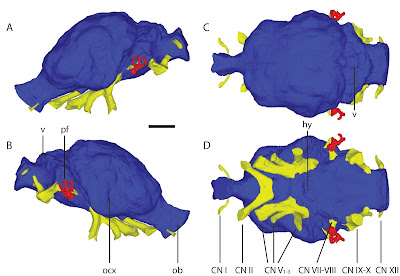Cuff AR, Stockey C, Goswami A, 2017. Endocranial morphology of the extinct North American lion (Panthera atrox). Brain, Behavior and Evolution. DOI: 10.1159/000454705.
To quickly catch everyone up, P. atrox is an extinct lion from North America (as the paper title suggests). The species evolved from a "cave" lion (P. spalaea) population from Eurasia that crossed the Bering Sea around 340,000 years ago. These lion populations in turn split from the lineage that gives rise to the modern lions 1.89 million years ago (Barnett et al., 2016).
 |
| Phylogeny of the lion species |
A quick note, endocasts are the natural cast (the infilling) of the endocranium (the braincase). In mammals the brain almost entirely fills the cavity so brain and endocast are almost identical (which is why brain swelling is such a major health issues). Birds are similar with their brains filling most of their endocast, but most non-avian dinosaurs and crocodiles have large sinuses that take up large volumes of the endocranium. Prior to our study the only data for P. atrox was from casts of skulls, (where they infilled brain cases with material to produce a cast) carried out in 1932 (Merriam and Stock, 1932). The new study adds some more details to those casts, as well as some additional information on the inner ear (red in the figure below).
 |
| Long line is total length, short line is "exposed" hindbrain not covered by the forebrain. |
Species
|
Cerebrum
and cerebellum length
|
“Exposed”
cerebellum length
|
Proportion
“exposed”
|
Dinobastis sp.*
|
0.0979
|
0.0095
|
0.097
|
Smilodon
fatalis*
|
0.0923
|
0.0124
|
0.134
|
Pseudaelurus*
|
0.0677
|
0.0165
|
0.243
|
Neofelis
nebulosi
|
0.0717
|
0.0168
|
0.235
|
Panthera
tigris
|
0.0999
|
0.0104
|
0.104
|
Panthera
pardus
|
0.0918
|
0.0160
|
0.175
|
Panthera
atrox
|
0.0984
|
0.0183
|
0.186
|
Panthera
leo
|
0.0905
|
0.0053
|
0.059
|
Pardofelis
marmorata
|
0.0550
|
0.0078
|
0.142
|
Carcal
aurata
|
0.0671
|
0.0093
|
0.139
|
Leopardus
wiedii
|
0.0517
|
0.0065
|
0.125
|
Lynx
rufus
|
0.0655
|
0.0106
|
0.163
|
Acinonyx
jubatus
|
0.0697
|
0.0080
|
0.115
|
Puma
concolor
|
0.0855
|
0.0131
|
0.154
|
Prionailurus
viverrina
|
0.0623
|
0.0108
|
0.174
|
Felis
silvestris
|
0.0499
|
0.0100
|
0.200
|
Proailurus*
|
0.0641
|
0.0141
|
0.220
|
What does this mean? Honestly I don't know. It's a weird quirk of felid morphology that deserves further study, so there is a project if anyone wants to collaborate.
Beyond the crazy brain shapes, what about their sizes? We measured the volume of the endocasts and multiplied it by standard brain tissue density (somewhere between 1.027 g/cm3 [Schröder, 1968] and 1.100 g/cm3 [Barber et al., 1970]). This was this compared to the body size to get a relative brain size.
 |
From Cuff et al., 2017. Figure 4.
Regression of log maximum brain mass against log body mass (both in kilograms)
for Felidae.
|
Most cats are fairly similar in relative brain size, with P. atrox slightly above that expected for its body mass. In addition, the absolute brain size (both of this endocast and some of the other P. atrox measured in 1932) is higher than any other felid species measured to date. But what does that mean for the intelligence? Actually in cats there doesn't appear to be an obvious correlation between brain size and sociality with similarly "brainy" cats being capable of both solo living and group living so we cannot say if P. atrox lived in prides like its modern relatives.
References
Barber TEDW, Brockway JA, Higgins LS (1970): The density of tissues in and about the. Acta Neurol Scand 46: 85–92.
Barnett R, Shapiro B, Barnes I, Ho SY, Burger J, Yamaguchi N, et al. (2009): Phylogeography of lions (Panthera leo ssp.) reveals three distinct taxa and a late Pleistocene reduction in genetic diversity. Mol Ecol Apr;18:1668–1677.
Merriam JC, Stock C (1932): The Felidæ of Rancho La Brea. Washington, Carnegie Institute of Washington.
Radinsky L (1975): Evolution of the felid brain. Brain Behav Evol 11:214–254.
Schröder R (1968): Über das spezifische Gewicht des Hirngewebes in der Nachbarschaft von Tumoren. Aus dem Max-Planck-Institut fur Hirnforschung, Abteilung fur Tumor forschung und expirementelle Pathologie, und der Neurochirurgischen Universitiitsklinik, Koln.
References
Barber TEDW, Brockway JA, Higgins LS (1970): The density of tissues in and about the. Acta Neurol Scand 46: 85–92.
Barnett R, Shapiro B, Barnes I, Ho SY, Burger J, Yamaguchi N, et al. (2009): Phylogeography of lions (Panthera leo ssp.) reveals three distinct taxa and a late Pleistocene reduction in genetic diversity. Mol Ecol Apr;18:1668–1677.
Merriam JC, Stock C (1932): The Felidæ of Rancho La Brea. Washington, Carnegie Institute of Washington.
Radinsky L (1975): Evolution of the felid brain. Brain Behav Evol 11:214–254.
Schröder R (1968): Über das spezifische Gewicht des Hirngewebes in der Nachbarschaft von Tumoren. Aus dem Max-Planck-Institut fur Hirnforschung, Abteilung fur Tumor forschung und expirementelle Pathologie, und der Neurochirurgischen Universitiitsklinik, Koln.


